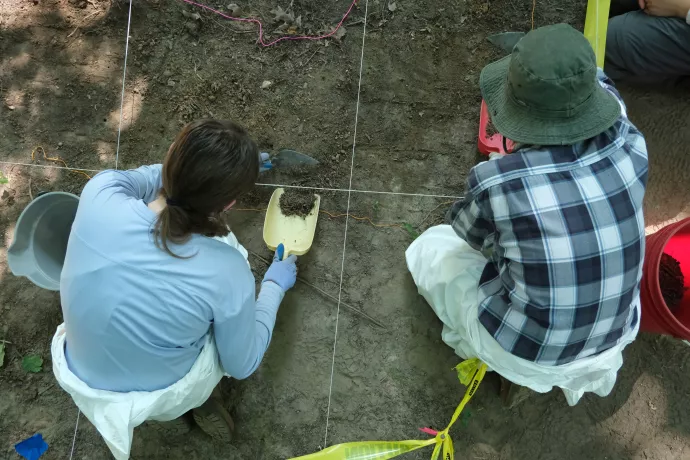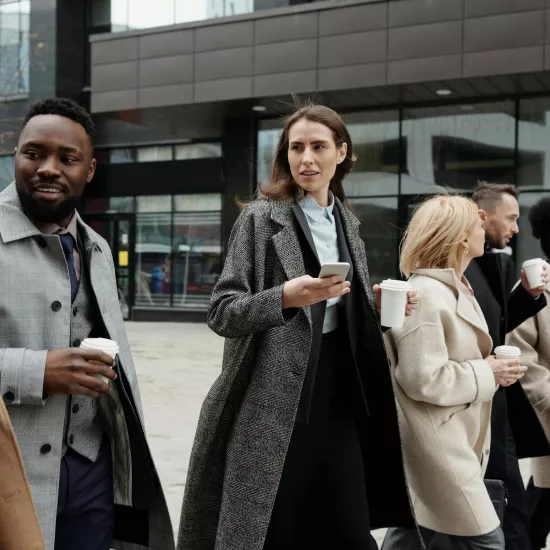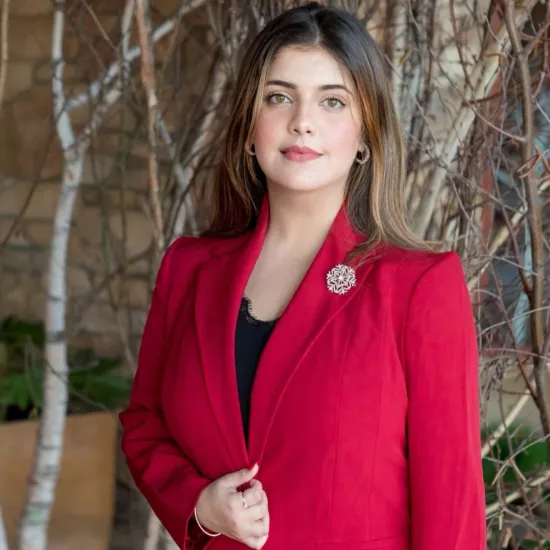UTM students gain hands-on experience, uncover new skills as part of forensic field school
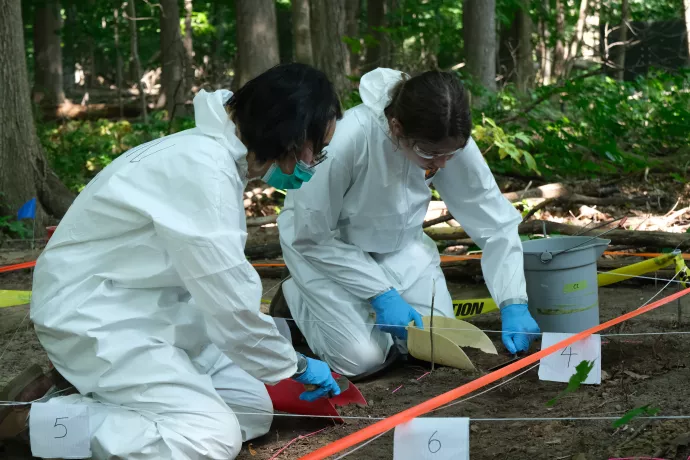
“Car!”
It’s the quintessential Canadian warning to clear the street for passing vehicles, but down on Principal’s Road, they aren’t playing street hockey.
They’re digging for evidence.
The forensic field school is out practicing their skills on a mock crime scene, this year staged east of the program’s Crime Scene House.
The documentation done here will follow the students for the rest of the semester, as they process their “evidence” during weekly two-hour lab sessions from September to December. At the end of the year, each group presents their findings to a mock court.
Although the “bones” on site are polymer casts and the decomposing “flesh” is pig parts from the local butcher, the skills and tools are very real.
“This is the same kit I have in my trunk when I go to scenes,” says Lelia Watamaniuk, a forensic anthropologist and consultant with Ontario Forensic Pathology Service who teaches ANT306 - Forensic Anthropology Field School. “It’s all an accurate professional experience.”
And forget the unlimited budget and space-age technology you see on TV crime shows, she says; another important skill learned in this field school is resource management.
“Real kits are a lot more Home Depot than CSI,” she says, pointing out an array of ski poles, tarps, elementary school protractors, gardening tools and duct tape laid out in plastic tubs on the side of the Principal’s Road. “It’s buckets and dental picks, paint brushes which are in pretty bad shape by the end of the week… all in just one or two kits. They have to learn to be creative.”
Out of the classroom, the students also learn teamwork, Watamaniuk says, smoothing out the kinks of group assignments, coordinating schedules, creating proper documentation and finding their roles on a team.
“Even if they never pursue a career in forensics, these are all transferable skills,” she says, noting forensic science is a broad subject that encompasses many different fields of study, including anthropology, biology, chemistry and psychology. “They can be quite competitive at the beginning, but they soon realize they have to work together to get the job done. They learn how to be professionals, not just students. They find their field voices.”
Third-year student Josie Fratarcangeli agrees.
“The focus is on the case, and not ourselves. Thus, it is integral that we work together as a team no matter what obstacles we face,” she says. The participants are selected by application from the third-year forensic anthropology stream, so they are already well-versed in theory, says Watamaniuk. Working in the field, though, often reveals findings not in their textbooks.
Challenges of working in the woods include weather, tripping hazards, wasp nests, poison ivy and ticks, Watamaniuk says.
Despite summer temperatures climbing into the 30s, the forensic trainees also learn to work in their white Tyvek suits (known colloquially as “bunny suits”). The waterproof polyethylene material protects them from exposure to biological hazards, and their evidence from cross-contamination, but, says Watamaniuk, they do add another level of challenge.
“Tyvek suits in the heat can be brutal, we have to remind each other to drink more water,” she says.
This time around, there were three teams working on a fabricated missing persons case.
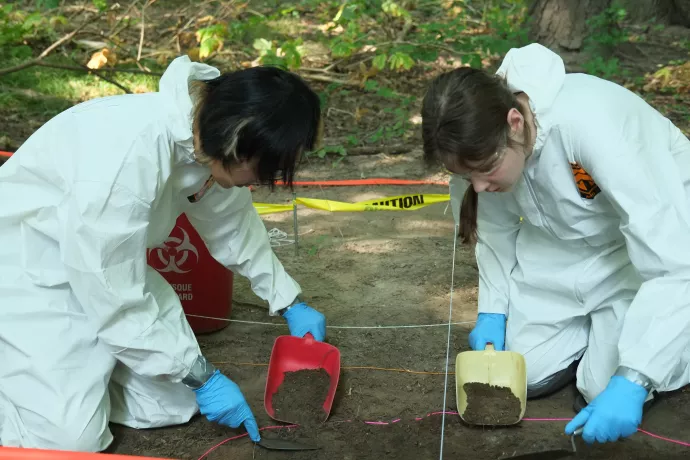
This is no fun campus scavenger hunt though, as the students work methodically, hand-drawing site maps, reviewing and implementing safety protocols, photographing details, keeping precise in/out personnel logs and crawling on their hands and knees to mark out a safe path to and from the crime scene, to ensure no evidence is disturbed.
In the two weeks, they practise such skills as fingerprinting, footwear impression preservation and blood stain analysis.
The one thing they don’t do, Watamaniuk says, is solve the crime.
“We are consultants, not cops or coroners,” she says. “But we collect and process the evidence they need to be able to do that.”
Watamaniuk was inspired to join the field after her aunt recommended books by real-life forensic anthropologist Dr. Kathy Reichs, the inspiration for TV’s Bones.
Student Danika Gauthier was also a Bones fan.
“It looked so mentally stimulating, after a few months I decided that this would be the career I would study for,” Gauthier says. “I was 12 years old at the time, so I did not know that the show was in parts exaggerated or what to expect from the actual job, but it definitely motivated me to study and work to reach my goal.”
Many students come to the program inspired by Hollywood’s visions of forensics, says Watamaniak.
“We do watch TV shows and things in class,” she says. “But it’s usually to point out what they are doing wrong. But they do sometimes inspire creativity, or make the students ask ‘can we try that?’”
Student Valencia Camelino agreed that fictional crime scenes skip over many important steps.
“Hollywood amps up the drama for entertainment,” she says. “The process of gathering evidence is far from quick. The process is much more detailed and methodical.”
Class of 2020 alum Jihwa Lim returned to the field school to help with a demonstration of 3D laser scanning, as a representative of ai2-3D, a company run by adjunct professor Eugene Liscio that specializes in 3D forensic measurement, analysis and visualizations for law enforcement and legal industries.
“A scan to document the scene is beneficial, to have it preserved in digitized format if you need to revisit something in the scene,” Lim says. “It only takes three to six minutes a scan, 30 minutes to an hour to capture the whole scene from multiple angles. Now, they will always have their crime scene.”
In addition to scanning their scenes, they also drew maps by hand and practised the old school skill of triangulation.
“It’s important they learn several different methods of doing the same thing,” said Watamaniuk. “It’s nice to have the tech, but what if it fails? Then you have nothing. In some smaller jurisdictions with smaller budgets, they may be using older equipment, so you need to know that too. Then, if all else fails, you need to know how to do it by hand. Once you know how to do that, you can do it anywhere, in any conditions.”
Lim, who earned a bachelor's degree with a specialty in forensic biology and a major in biology for health science while at UTM, also works as a sessional instructor with the program. She enjoys coming back every year to assist with the field school.
“My field study case was in the Crime Scene House,” she says, referring to the Principal’s Road cottage (also known around campus as the “Murder House” or “CSI House”). Just a short distance from this year’s site, it was originally built for then-property resident, English artist Charlotte Schreiber, reportedly in 1877, which would make it the oldest building on UTM grounds. It was adopted by the forensics program in 2009 to provide students with hands-on training.
Like Lim, field school alumni can be found in many of Canada’s crime-fighting forces, including medical teams, Ontario Fire Marshall’s Office; Ontario’s Centre of Forensic Sciences; Ontario Forensic Pathology Services; York, Peel, Halton and Toronto police services and the RCMP.
Each agency has their own preferred procedures, says Watamaniuk, so the field school protocols approximate an average of the many services.
Searching for crime scenes
Before they can collect evidence though, the students have to find the crime scenes. Starting with a whole 225-acre campus to scope out, the teams used clues and details from “witnesses” to narrow down the most likely locations.
“This is about theory and skill, recon and triangulation, probability,” says Watamaniuk. “This is their chance to practise their critical thinking.”
The field school also gives students a chance for trial-and-error before they join the professional world.
“Here, mistakes are data,” she says. “They learn to do better next time. It’s all about improvement.”
UTM’s forensic science program is the oldest in Canada and the field school has been part of the forensic training for more than 20 years, honed by former program director Professor Tracy Rogers, a forensic anthropology consultant for the Ontario Forensic Pathology Service in the Office of the Chief Coroner of Ontario.
“This is a finely tuned machine,” says Watamaniuk, who took part in the field school in 2007 as part of her master’s degree under Rogers.
The department begins preparing the crime scenes two weeks before the field school.
“We do this part in the summer because there is less traffic on campus, and also because we are able to include everyone,” she says. “We work with security, grounds help create the scenes, we run the search plans by the safety office. (Professors) Michael Brand and Trevor Orchard from archeology help create the ‘gravesites.’”
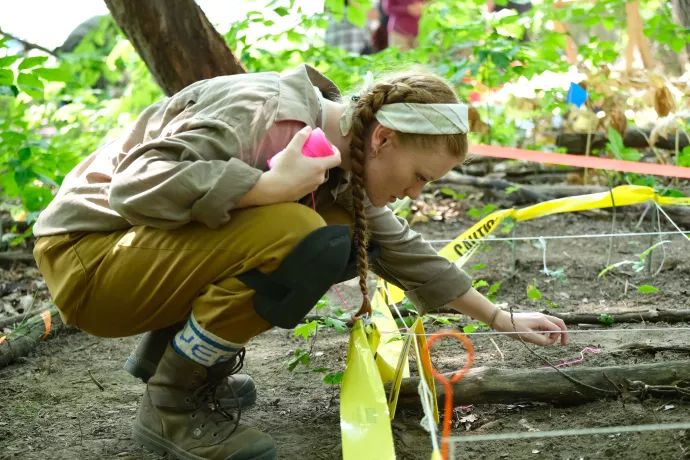
And the location is a strictly guarded secret until the teams crack the mystery.
“Even the TAs aren’t told, so they can’t accidentally give us any clues,” says student Emma-Marie Meyer, as she laid out a string on her team’s plot for a grid search. “It’s not as easy as you think, they have not made this easy for us, the signs are very subtle. Our site was covered with leaves.”
She says she was surprised how difficult it is to spot a crime scene out in the field.
“I thought it would be obvious, but we did not see it, even though we were standing just a few feet from it,” says Meyer, who transferred to UTM in her second year specifically to take part in the forensic field school.
In the end, it was a tiny clue that tipped them off.
“We noticed dirt on top of a stick, then we noticed some of the soil was clumpy and disturbed, with bits of sticks mixed in,” she says. “That’s not something that naturally happens. Someone had been there.”
Although excited to get to work, they remembered the advice of their TAs.
“They did tell us that sometimes the process can seem very tedious but it’s important to do everything carefully,” she says. “Be gentle with every leaf.”
In the field, they learn why all the steps are important, says Camelino.
“It really highlights the extensive considerations required when working in forensic science. There is a lot to remember, but it is absolutely worth it in the end.”
Above all, Gauthier appreciated the field school’s opportunity for practical experience.
“It allowed me to see what the work of a forensic anthropologist really is day-to-day, to see for myself whether that would be something I would like to do for the rest of my working life,” she says. “I would say that something that surprised me is the number of steps taken to ensure objectivity and to preserve evidence, in a legal and physical sense. I knew it was regulated and strict, but some of the things we were doing to ensure evidence preservation were things I never would have thought of doing on my own.”
At the end of the two weeks, says Watamaniuk, the students return the scenes to their original state, making sure to leave nothing behind.
“We have to do a lot of documentation – documentation is everything in forensics,” she says. “(During setup) we take plenty of videos and photos so we remember where we left everything.”
And, unlike their scenario’s “criminals,” the students also do some good.
“They even clean up the litter,” Watamaniuk says, with a laugh.
